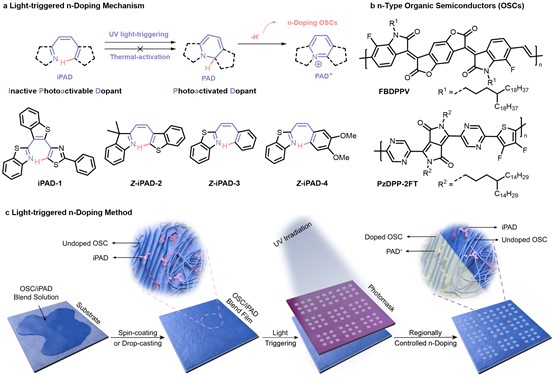
Peking University, May 29, 2025: A research team led by Professor Pei Jian at Peking University achieved breakthrough in regionally controlled n-doping of organic semiconductors via a light triggered strategy. These findings, entitled “Light-triggered regionally controlled n-doping of organic semiconductors” were published in Nature on May 28, 2025.
Why it matters
The resolution of regional doping directly determines device dimension and performance in integrated circuit manufacturing. However, conventional doping strategies for organic semiconductors (OSC) remain challenges to achieve high-resolution and regionally controlled doping.
Methodology
Professor Pei Jian’s research team at Peking University developed a novel class of inactive photoactivable dopants (iPADs), which can be converted in situ into highly reactive photoactivated dopants (PADs) under light irradiation. This innovative approach enables efficient, precise, and regionally controlled doping of organic and polymeric semiconductors. By overcoming the limitations of traditional chemical doping in terms of regional resolution and controllability, the team successfully achieved submicron-scale n-type doping with electrical conductivity exceeding 30 S/cm of polymeric semiconductors. This advance further enables photopatterned fabrication of organic integrated circuits, paving the way for revolutionary progress in organic electronics.
Key Findings
1. Novel doping mechanism
The molecular design of iPADs with “thermally inert but photoactivable” characteristics enables a controlled doping process of organic and polymeric semiconductors. These precursors remain chemically inactive during standard micro/nanofabrication processes (e.g., photoresist baking, thermal evaporation) but rapidly convert to highly active dopants (PADs) upon ultraviolet exposure. This allows efficient n-type doping of organic and polymeric semiconductors, with electrical conductivity increasing up to 9 orders of magnitude.
2. General and efficient doping capability
A variety of iPAD molecules have been synthesized and successfully applied to over ten representative polymeric semiconductors, achieving consistent conductivity enhancement. This significantly broadens the applicability of organic and polymeric semiconductors across different technologies.
3. Regionally controlled doping down to submicron-scale resolution
The light-controlled doping strategy is fully compatible with standard photolithographic workflows in the semiconductor industry. For the first time, submicron-scale doping resolution has been demonstrated in polymeric materials. This establishes a vital technological foundation for fabricating high-performance organic integrated circuits, with excellent feasibility for industrial implementation.
